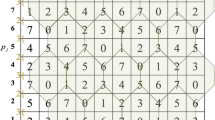Abstract
Reversible data hiding (RDH) is a technology that embeds secret data into a carrier where both the secret data and the carrier can be recovered without any data loss. Inspired by dual images technology, this article proposes to employ a high capacity RDH scheme that is based on turtle shell (TS). We start by constructing a newly designed TS-based reference matrix. Then, two meaningful shadows will be generated after hiding the secret data in the cover image with the reference matrix’s help. Meanwhile, the location conflict problem is solved. On the decoder side, when both shadows are gathered, the data extraction and image recovery can be accomplished using the orientation relationship between two stego pixels that are located at the same coordinates in the two shadows and the reference matrix. Moreover, we introduce a security enhancement technology that improves the security of data extraction. The experiment shows that compared with other state-of-the-art RDH schemes, a higher embedding capacity is achieved by this method, and a good visual quality is retained. Simultaneously, the proposed scheme is effective against attacks on pixel value difference histograms (PDH) and regular singular (RS) analysis.











Similar content being viewed by others
Abbreviations
- RDH:
-
Reversible data hiding.
- DE:
-
Different expansion.
- HS:
-
Histogram shifting.
- PVO:
-
Pixel value ordering.
- TS:
-
Turtle shell.
- ER:
-
Embedding ratio.
- PSNR:
-
Peak signal-to-noise ratio.
- PDH:
-
Pixel value difference histograms.
- RS:
-
Regular singular.
References
Alattar A (2004) Reversible watermark using the difference expansion of a generalized integer transform. IEEE Trans Image Process 13(8):1147–1156
Chang CC, Chou YC, Kieu TD (2008) An information hiding scheme using Sudoku. In: Proceedings of third international conference on innovative computing, information and control, Dalian, China, pp 17–22
Chang CC, Chou YC, Kieu TD (2009) Information hiding in dual images with reversibility. In: Proceedings of the third international conference on multimedia and ubiquitous engineering, Qingdao, China, pp 145–152
Chang CC, Kieu TD, Chou YC (2007) Reversible data hiding scheme using two steganographic images. TENCON 2007–2007 IEEE Region 10 Conference, IEEE, pp1–4, 2007
Chang CC, Li CT (2019) Algebraic secret sharing using privacy homomorphisms for IoT-based healthcare systems. Math Biosci Eng 16:3367–3381
Chang CC, Li CT, Shi YQ (2018) Privacy-aware reversible watermarking in cloud computing environments. IEEE Access 6:70720–70733
Chang CC, Li CT, Chen K (2019) Privacy-preserving reversible information hiding based on arithmetic of quadratic residues. IEEE Access 7:54117–54132
Chang CC, Liu YJ, Nguyen TS (2014) A novel turtle shell based scheme for data hiding. In: Proceedings of tenth international conference on intelligent information hiding and multimedia signal processing, Kitakyushu, Japan, pp 89–93
Di F, Zhang M, Liao X, Liu J (2019) High-fidelity reversible data hiding by Quadtree-based pixel value ordering. Multimed Tools Appl 78:7125–7141
Fridrich J, Goljan M, Du R (2001) Reliable detection of LSB steganography in grayscale and color images. In: Proceedings ACM, special session on multimedia security and watermarking, Ottawa, Canada, October 5, pp 27–30
Huynh NT, Bharanitharan K, Chang CC (2015) Quadri-directional searching algorithm for secret image sharing using meaningful shadows. J Vis Commun Image Represent 28:105–112
Jia Y, Yin Z, Zhang X (2019) Reversible data hiding based on reducing invalid shifting of pixels in histogram shifting. Signal Process 163:238–246
Lee CF, Huang YL (2013) Reversible data hiding scheme based on dual stegano-images using orientation combinations. Telecommun Syst 52:2237–2247
Li X, Li B, Yang B, Zeng T (2013) General framework to histogram-shifting-based reversible data hiding. IEEE Signal Process Lett 22(6):2181–2191
Li XL, Li J, Li B, Yang B (2013) High-fidelity reversible data hiding scheme based on pixel-value-ordering and prediction-error expansion. Signal Process 93(1):198–205
Lin JY, Liu YJ, Chang CC (2019) A real-time dual-image-based reversible data hiding scheme using turtle shells. J Real-Time Image Proc 16(3):673–684
Liu YJ, Chang CC (2018) A turtle shell-based visual secret sharing scheme with reversibility and authentication. Multimed Tools Appl 77(19):25295–25310
Lu TC, Chang TC, Shen JJ (2020) An effective maximum distortion controlling technology in the dual-image-based reversible data hiding scheme. IEEE Access 8:90824–90837
Ni Z, Shi YQ, Ansari N, Su W (2006) Reversible data hiding. IEEE Trans Circuits Syst Video Technol 16(3):354–362
Peng F, Li XL, Yang B (2014) Improved pvo-based reversible data hiding. Digital Signal Process 25:255–265
Qu XC, Kim HJ (2015) Pixel-based pixel value ordering predictor for high-fidelity reversible data hiding. Signal Process 111:249–260
Tian J (2003) Reversible data embedding using a difference expansion. IEEE Trans Circuits Syst Video Technol 13(8):890–896
Tsai PY, Hu YC, Yeh HL (2009) Reversible image hiding scheme using predictive coding and histogram shifting. Signal Process 89(6):1129–1143
Wang X, Ding J, Pei Q (2016) A novel reversible image data hiding scheme based on pixel value ordering and dynamic pixel block partition. Inf Sci 310:16–35
Xie XZ, Chang CC et al (2019) A turtle shell based RDH scheme with two-dimensional histogram shifting. Multimed Tools Appl 78(14):19413–19436
Xie XZ, Chang CC, Lin CC (2019) A hybrid reversible data hiding for multiple images with high embedding capacity. IEEE Access 8:37–52
Yao H, Mao F, Tang Z (2020) High-fidelity dual-image reversible data hiding via prediction-error shift. Signal Process 170:107447
Zhang XP, Wang SZ (2006) Efficient steganographic embedding by exploiting modification direction. IEEE Commun Lett 10(11):781–783
Acknowledgements
This work is supported by Scientific Research Foundation for the Introduction of Talent at Xiamen University of Technology ( YKJ21007R ) and the Open Fund of Engineering Research Center for Software Testing and Evaluation of Fujian Province.
Author information
Authors and Affiliations
Corresponding author
Additional information
Publisher's note
Springer Nature remains neutral with regard to jurisdictional claims in published maps and institutional affiliations.
Rights and permissions
About this article
Cite this article
Xie, XZ., Chang, CC. Hiding data in dual images based on turtle shell matrix with high embedding capacity and reversibility. Multimed Tools Appl 80, 36567–36584 (2021). https://doi.org/10.1007/s11042-021-11368-z
Received:
Revised:
Accepted:
Published:
Issue Date:
DOI: https://doi.org/10.1007/s11042-021-11368-z




